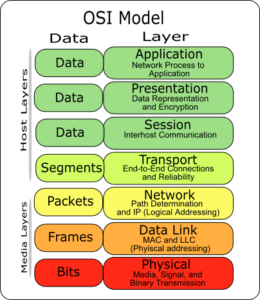NF Post 1 : OSI 7 Layers
About Layered Protocol
Assume there are process A and B
To prevent chaos, A and B have to agree on the meaning of the bits being sent
If :
- Process A → Send message to B encoded in IBM’s EBCDIC character code
- Process B → Expect to received message encoded in ASCII
communication will be less than optimal, many different agreements are needed
Solution:
Developed a reference model that clearly identifies the various levels involved, gives them standard names, and points out which level should do which job

Lower-Level Layers
Physical Layer
Deals with standardizing the electrical, mechanical, and signaling interfaces so that when one machine sends a 0 bit it is actually received as a 0 bit and not a 1 bit
Data Link Layer
Communication has errors → task of data link layer is to detect and correct them
- Put a bit pattern on the start and end of each frame
- Computing a checksum by adding up all the bytes in the frame in a certain way
Network Layer
In Wide Area Network with large number of machines, a message may have to make a number of hops to reach the receiver at each one choosing an outgoing line to use
Routing → choosing the best path, the task of network layer
Transport Layer
Transport Layer
- Providing a reliable connection
- work transparently within the layers above to deliver and receive data without errors
Sender side breaks application messages into segments and passes them on to the network layer
Receiver side then reassembles segments into messages and passes them to the application layer
Higher-Level Layers
Session Layer
- provides dialog control (keep track of which party is currently talking)
- provides synchronization facilities
Presentation Layer
While lower layers concerned about getting the bits from sender to receiver, presentation layer is concerned about the meaning of each bits. Most messages are not random bit strings, but more structure informations such as people’s name.
This layer makes defining field like these possible and then have the sender notify the receiver that a message contains a particular record in a certain format
Application Layer
Container for all applications and protocols that in one way or the other do not fit into one of the underlying layers
Middleware
Software that provides services beyond those provided by the operating system to enable the various components of a distributed system to communicate and manage data
Sits between the client-side request on the front end and the back-end resource being requested
Examples of middleware communication services:
- Remote procedure calls
- Message queuing services
- Support for communication of continuous media through streams
- Multicasting
References :
- Image link
- Andrew S. Tanenbaum, Maarten Van Steen – Distributed Systems Principles and Paradigms (2nd Edition)